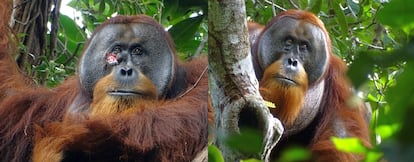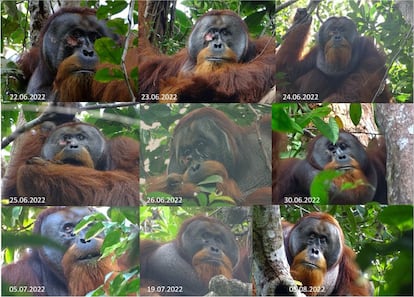Rakus, the first orangutan seen healing a wound with a medicinal plant
The ape covered his face with chewed leaves that contain berberine, an extract that is available in pharmacies

Fibraurea tinctoria is a climbing plant found in the jungles of Southeast Asia. Many of the local communities use it as a medicinal herb to treat various diseases such as diabetes, malaria and digestive problems. Modern science has found that it contains diterpenoid furans, which have antibacterial, anti-inflammatory, antioxidant and fungicidal properties. The plant also has high concentrations of two alkaloids, particularly protoberberine, the origin of berberine, a compound that is easy to find in parapharmacies and which has been called nature’s Ozempic. Now, for the first time, researchers have seen a male orangutan create a poultice with the leaves of F. tinctoria to treat a wound under his eye. The animal chewed the leaves and applied the poultice to his face: a few days later, the ulcer had closed and in two months the scar was barely visible.
This pioneering ape is called Rakus, and he is a Sumatran orangutan (Pongo abelii), a species of which there are only 7,500 surviving animals. His exact age is not known, but it is known that he was born in the 1980s. Rakus lives in the Suaq Balimbing jungle, and by 2021, he had already developed his bridles, the fatty cheek pads that indicate sexual maturity. On the morning of June 22, 2022, researchers heard a rare vocal fight between two male orangutans, where particular vocalizations are used to indicate control of a territory and its females. At noon, they saw Rakus’ injury for the first time. Under his eye, he had a deep wound. Although they did not witness the fight, observers on the ground believe it was the result of the morning’s shouting match. Three days later, they observed a new behavior: Rakus plucked F. tinctoria leaves and, after chewing them for a while, without swallowing them, applied their juice to the wound. Shortly afterward, when the flies were preying on the open sore, he chewed new leaves again and fully covered the wound with them.
“Interestingly, Rakus also rested more than usual while he was injured,” says Isabelle Laumer, a researcher at the Max Planck Institute for Animal Behavior (Germany) and lead author of the study. “Sleep positively affects wound healing, since during sleep the release of growth hormone, protein synthesis and cell division increase,” she adds. Adult male orangutans spend half their time resting or sleeping. But, during his convalescence, Rakus was resting 30% more than in the months before and after the injury. The day after applying the chewed leaves, he ate stems and leaves of the same plant, something he did not do again in the days that followed. In the following days, the wound remained free of infection and, by June 30, it had already closed. In mid-July, only a small scar remained, and Rakus returned to his usual pace of activity. All the details of the Rakus healing process were reported in a work published in the scientific journal Scientific Reports.
According to the authors, this is the first time that this behavior has been recorded. Although there are many species that follow hygiene practices, such as avoiding feces or bad water or food, there has never been such a direct and intentional practice as applying chewed leaves to heal an open wound.
Caroline Schuppli, also from the Max Planck Institute for Animal Behavior, recalls in an email that “in general, there is little evidence of health-related behaviors in orangutans.” However, according to Laumer, in the orangutans of neighboring Borneo, which are considered another species, “it has been observed that individuals from different populations ingest specific plant species that are also used in ethnomedicine for their medical properties.” She adds: “It is possible that orangutans have ingested these plants to treat different medical conditions.”
A few years ago, another group of researchers announced that they had observed several females and one male Bornean orangutan (Pongo pygmaeus) mixing leaves from a shrub, the Dracaena cantleyi, with saliva and rubbing it on their skin. Pharmacological analysis of this plant showed that it contains an inhibitor of cytokine production, which gives it anti-inflammatory and analgesic properties. “They used plants with medical properties, but no wounds or skin conditions were observed on the orangutans’ bodies; it is possible that these orangutans used plants to treat pain,” recalls Schuppli. “Our observation is the first documented case of wound treatment by a wild animal with a plant with medicinal properties.”
The behavior of Rakus is truly exceptional and could be what the authors call “a case of individual innovation.” Schuppli suggests an explanation for the origin of this practice: “Some individuals may have accidentally touched their wounds while feeding on this plant and therefore involuntarily applied its juice to them. As F. tinctoria has powerful analgesic effects, they were able to feel immediate pain relief, which would make them repeat the behavior more times.” To settle the issue, they point out, it would be key to observe other orangutans from Rakus’ home group. This, however, is complicated. In this species, males leave their place and community of birth when they reach the adult phase of their life, sometimes moving hundreds of miles away. It is unknown where Rakus was born and from whom he may have learned how to heal his wounds.

In the archives of the Suaq Balimbing research center, they have 28,000 hours of observation of some 150 orangutans over the past 21 years. And they had never seen another case of Rakus’ behavior. Laumer argues that since it is a difficult practice to observe, Rukus may not be the exception: “It may be due to the fact that we rarely find injured orangutans in Suaq. Due to the high availability of food, the high social tolerance among orangutans and the relatively stable social hierarchies (each area is usually inhabited by a dominant male and several females), there is little physical fighting, and therefore we rarely encounter injured orangutans.”
Orangutans are not the only great apes that take care of their health. The pioneering primatologist Jane Goodall, in the 1960s, observed the presence of leaves of no nutritional interest in the feces of chimpanzees. Decades later, it was confirmed that these leaves helped chimpanzees expel intestinal parasites. In the following years, it has been proven that chimpanzees, bonobos and gorillas ingest plants with healing properties. But this was nothing compared to what was seen between 2019 and 2021 in a group of chimpanzees in Loango National Park (Gabon). During 15 months of observations, researchers witnessed around 20 occasions in which a member of the group with injuries captured one or more winged insects, immobilized them by tearing off their wings with their mouths, and placed them directly on the wound for a few moments. They also saw the animals do this with other injured family members. Although they published the discovery in a short letter in the scientific journal Current Biology, they could not identify which insects had been captured, so they could not confirm their healing potential.
Simone Pika, from the Institute of Cognitive Science at the University of Osnabrück (Germany) and senior signatory of that letter, says that her laboratory now has a researcher on the ground trying to answer that question. “He is collecting data and working with entomologists to identify which insects they are using,” she says in an email. Once identified, “the last step will be to investigate whether there are antibacterial, soothing or anti-inflammatory substances in the species used,” adds Pika, who highlights that the behavior the researchers observed is common in this community. They hope to publish the results of their work next year, meaning the orangutan Rakus could lose his status as the first great ape to heal a wound with a medicinal plant.
Sign up for our weekly newsletter to get more English-language news coverage from EL PAÍS USA Edition
Tu suscripción se está usando en otro dispositivo
¿Quieres añadir otro usuario a tu suscripción?
Si continúas leyendo en este dispositivo, no se podrá leer en el otro.
FlechaTu suscripción se está usando en otro dispositivo y solo puedes acceder a EL PAÍS desde un dispositivo a la vez.
Si quieres compartir tu cuenta, cambia tu suscripción a la modalidad Premium, así podrás añadir otro usuario. Cada uno accederá con su propia cuenta de email, lo que os permitirá personalizar vuestra experiencia en EL PAÍS.
¿Tienes una suscripción de empresa? Accede aquí para contratar más cuentas.
En el caso de no saber quién está usando tu cuenta, te recomendamos cambiar tu contraseña aquí.
Si decides continuar compartiendo tu cuenta, este mensaje se mostrará en tu dispositivo y en el de la otra persona que está usando tu cuenta de forma indefinida, afectando a tu experiencia de lectura. Puedes consultar aquí los términos y condiciones de la suscripción digital.
More information
Archived In
Últimas noticias
Most viewed
- Sinaloa Cartel war is taking its toll on Los Chapitos
- Oona Chaplin: ‘I told James Cameron that I was living in a treehouse and starting a permaculture project with a friend’
- Reinhard Genzel, Nobel laureate in physics: ‘One-minute videos will never give you the truth’
- Why the price of coffee has skyrocketed: from Brazilian plantations to specialty coffee houses
- Silver prices are going crazy: This is what’s fueling the rally











































